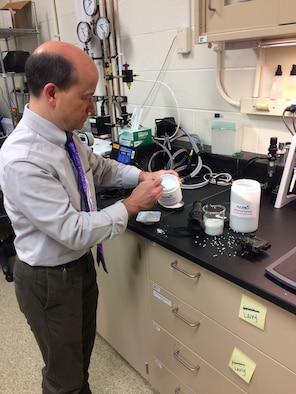
A year ago, Dr. Larry Brott of the Air Force Research Laboratory, along with his co-inventors, licensed a technology for a pressure-activated marker that allows troops to communicate with written messages in low or no-light conditions, with or without night vision devices.
This marker, along with a second patent by Brott and his team involving infrared phosphor technology, has recently been licensed to Battle Sight Technologies, which expands to their existing collection of infrared technologies. This technology works similarly to the dials on a watch, absorbing ultraviolet light during the day and emitting an infrared light at night.
This suite of infrared products, such as glow sticks or patches and packs displaying glow-in-the-dark reflective strips, are all used for battlefield communication and training. Additionally, these products are used to identify U.S. military locations to friendly ground forces and aircraft.
Identification is a must when troops are partnering with foreign forces, including uniformed soldiers using civilian trucks.
In March, the Air Force awarded Battle Sight Technologies $165,000 to continue developing products based off the core patches, tapes and molded parts to support low-light/no-light communication.
“Through express tech licensing, it is easy to discover which technologies are available and also learn about pre-negotiated terms and pricing,” said Sunita Chavan, Materials and Manufacturing Technology Transfer Office lead. “There is total transparency. If a company is interested in entering into a licensing agreement, they can complete an easy application.”
“One-stop shopping” is a term Chavan uses to explain express tech licensing. The user-friendly process makes Air Force technologies available to companies of all sizes while eliminating lengthy contract negotiations associated with government patent licensing.
Predetermined upfront fees and royalty fees make the express licensing platform an easy option, according to Chavan.
The next steps include learning how to scale-up the production process. “We are used to making small, lab-scale batches where we can produce 15 crayons per day,” Brott said. “We are getting such interest in this product that we are now being asked to make 200 crayons daily.”
Various “flavors” of crayons are also being requested to match different scenarios. Infrared crayons that leave no trace, and crayons that glow visibly at night while leaving a bright pink pigment mark for daytime viewing are some examples.
These variations are for first responders who might answer to a night-time train wreck. After searching a train car, they would mark it so that it would be visible at night, and also apparent once the sun rises.
“We are working hard to meet a deadline, for a ‘first responder’ convention in October and anticipating a much larger demand for the crayons after the word gets out,” Brott said.
https://ift.tt/2Z7iyRp

0 Response to "AFRL licenses second technology to local firm > US Air Force > Article Display - Air Force Link"
Post a Comment